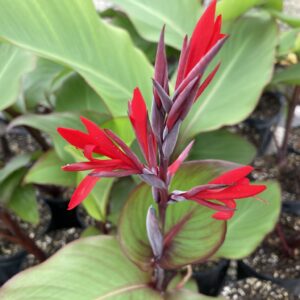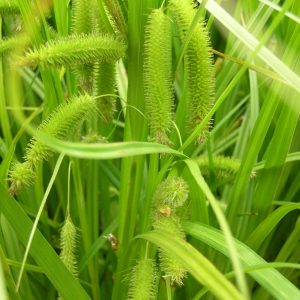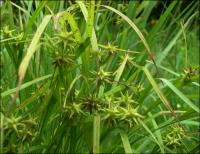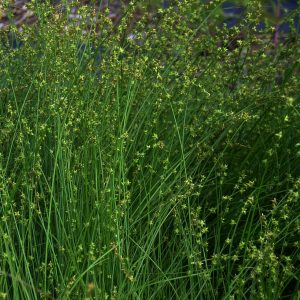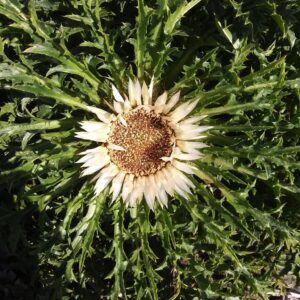Shop
Showing 153–160 of 788 results
-
Canna edulis Indian shot, Arrowroot Z 7-10
Several shoots of red, tube-like flowers atop a tall stalk , taller than its banana plant-like, broad, waxy, oval foliage, green with purple toward the top. Flower all summer.
Several shoots of red, tube-like flowers atop a tall stalk , taller than its banana plant-like, broad, waxy, oval foliage, green with purple toward the top. Flower all summer.
Size: 8’ x 3’ spreading
Care: sun in moist to moist well-drained. In colder Zones, lift and overwinter indoors.
Native: Andes of South America, and the West Indies
Wildlife Value: attracts bees, hummingbirds and butterflies.
Size: Primarily grown as a root crop to eat, roast or boil root like a potato. Root is source of arrowroot used as thickener.Edulis means edible.
Carbon dating of tubers shown grown more than 3500 years ago.**LISTED AS OUT OF STOCK BECAUSE WE DO NOT SHIP THIS ITEM. IT IS AVAILABLE FOR PURCHASE AT OUR RETAIL LOCATION.
-
Caragana rosea Pink peashrub Z 3-8
Rose-pink , pea like flowers May-June on prior years wood. Flowers give way to slender yellowish-green seed pods that mature to brown in late summer. Yellowish fall color.
ARCHIVED
Note: This is a plant not currently for sale. This is an archive page preserved for informational use.
Rose-pink , pea like flowers May-June on prior years wood. Flowers give way to slender yellowish-green seed pods that mature to brown in late summer. Yellowish fall color.
Size: 3-4’ x 3-4’
Care: full sun to light shade in dry to medium, well-drained soil. Perfom well in areas with hot summers and cold winters.
Native: Slopes and valleys in central and NE China, Japan and Russia
Wildlife Value: Attracts bees, butterflies and hummingbirds. Deer resistantPlants are considered to be xerophilous (capable of thriving in dry, hot locations). Described by Nicolai Stepanowitsch Turczaninow in Primitiae Florae Amurensis 470. 1859
-
Carex comosa Longhair sedge, Bristly sedge Z 4-10
Ornamental dangling bottle brush spikes from May to August
OUT OF STOCK
Ornamental dangling bottle brush spikes from May to August
Size: 2-4’ x 2’
Care: Sun to part shade in wet to moist soil
Native: all of sub-Arctic No. America except western intermountain states and provinces and except Alaska.
Wildlife Value: food for caterpillars of several butterflies. Seeds provide food for wetland birdsRhizomes stabilize shorelines while plants give ducks cover and the seeds provide food. Good rain garden plant.
-
Carex davalliana Bath’s sedge, Davall’s sedge Z 4-8
Short hedge-hog like clump with white flowers
ARCHIVED
Note: This is a plant not currently for sale. This is an archive page preserved for informational use.
Short hedge-hog like clump with white flowers turning to bronzy spiked seedheads May-June. Best for rock, railroad or fairy gardens – anyplace for a miniature, clumping grass.
Size: 6” x 12”
Care: sun to light shade in moist soil
Native: wet places in Europe and western No. AmericaCollected before 1798 by Edmund Davall who botanized in Switzerland.
-
Carex grayi Gray’s Sedge Z 3-8
Cool club-like maces at the ends of stems- June to October
Cool club-like maces at the ends of stems- June to October
Size: 30" x 24"
Care: Full sun to part shade in moist or moist well-drained soil
Native: Vermont west to Wisconsin, south to Georgia and Missouri
Awards: Great Plants for Great Plains1st described in Vol VII of Transactions of Linnaean Society c. 1798. Botanists named and renamed it finally settling on Carex grayi to honor botanist Asa Gray (1810-1888).
-
Carex montana Soft-leaved Sedge Z 4-10
Soft mounding grass with small brown flower spikes March-April
ARCHIVED
Note: This is a plant not currently for sale. This is an archive page preserved for informational use.
Soft mounding grass with small brown flower spikes March-April
Size: 10” X 10”
Care: Part sun to shade in well-drained soil
Native: Europe, Caucasas, West SiberiaLinnaeus 1753
-
Carex rosea Rosy sedge, Stellate sedge PERENNIAL GRASS Z 3-9
Mounds of thinnest of medium green leaves mingled with stems with star shaped seed clusters in May-June
OUT OF STOCK
Mounds of thinnest of medium green leaves mingled with stems with star shaped seed clusters in May-June.
Size: 12” x 10”
Care: part shade and shade in moist well-drained soil
Wildlife Value: No. Dakota south to TX & east incl. WI, New Brunswick and Nova Scotia.
Awards: Great Plants for the Great Plains Grass of the Year 2020Collected before 1811.
-
Carlina acaulis ssp. simplex Silver thistle, Weather thistle Z 3-9
Wide, white saucer flowers above silvery thistle foliage, open on dry days, closed in the evenings and on rainy days. July- September
OUT OF STOCK
Wide, white saucer flowers above silvery thistle foliage, open on dry days, closed in the evenings and on rainy days. July- September
Size: 6-12” x 12”
Care: sun in well-drained soil.
Native: Southern & Eastern Europe
Wildlife Value: attracts honey-beesThe Genus comes from Charles (Carolus). According to medieval folklore Charlemagne used this root to cure the ills of his troops.

